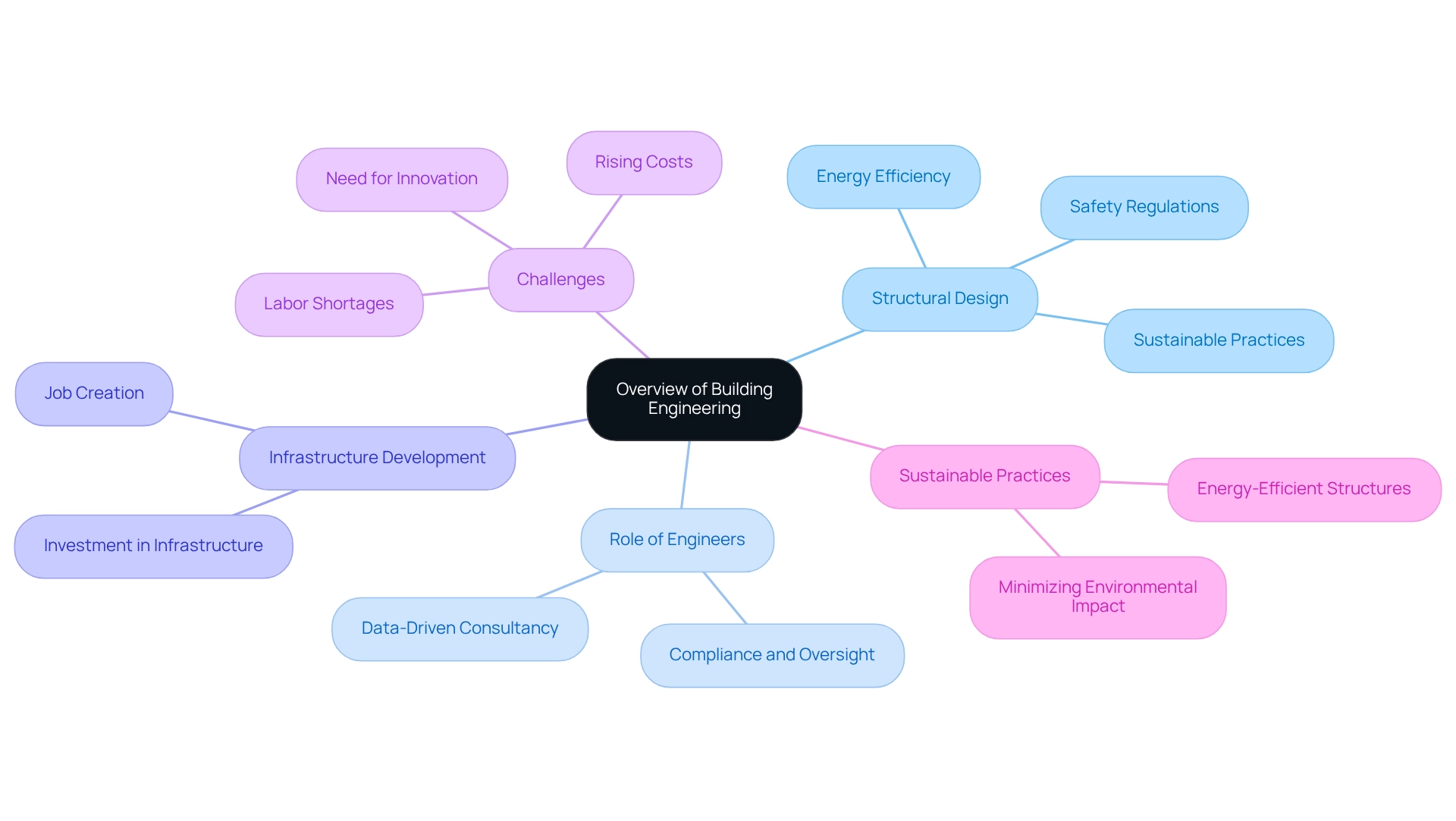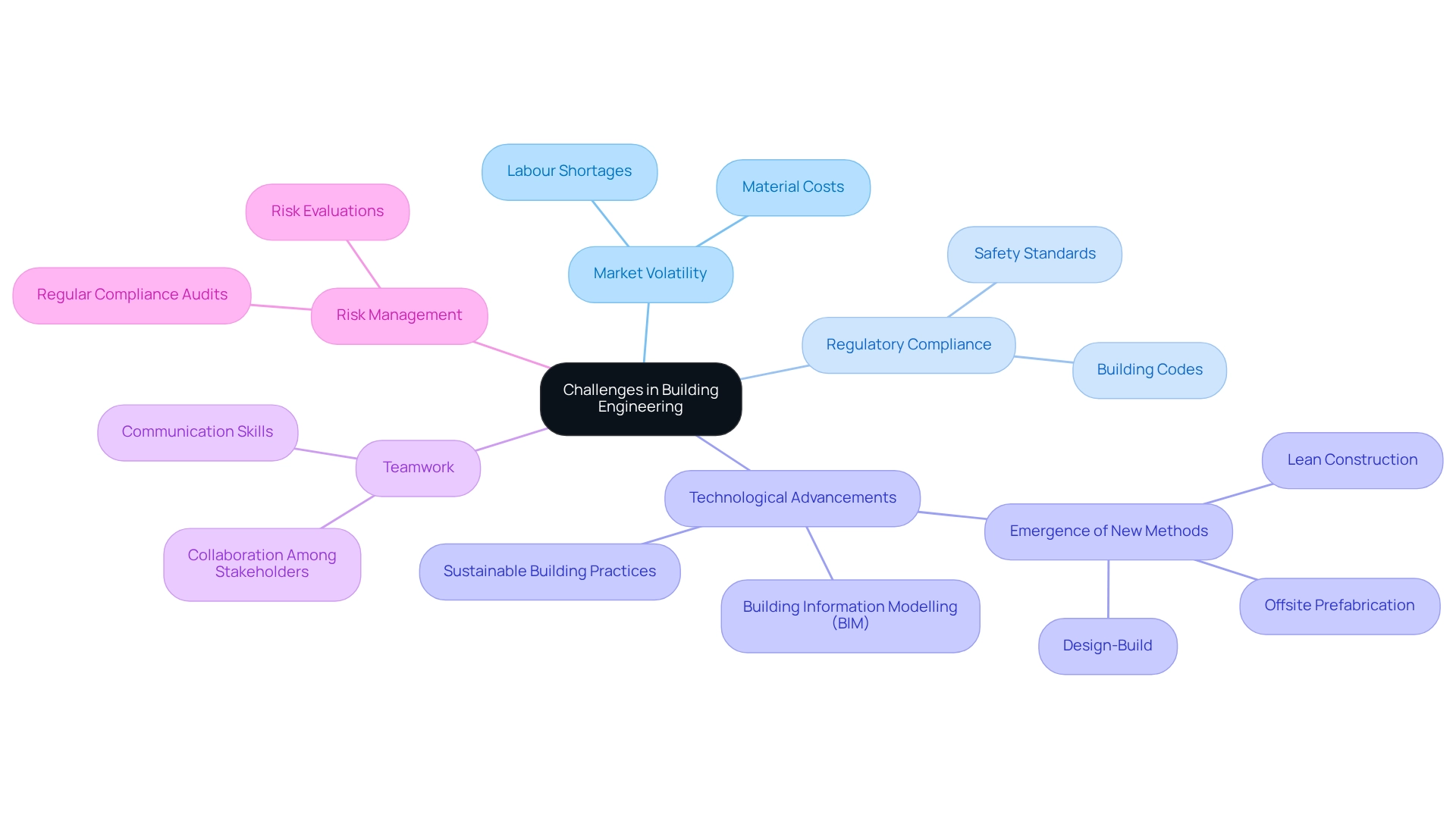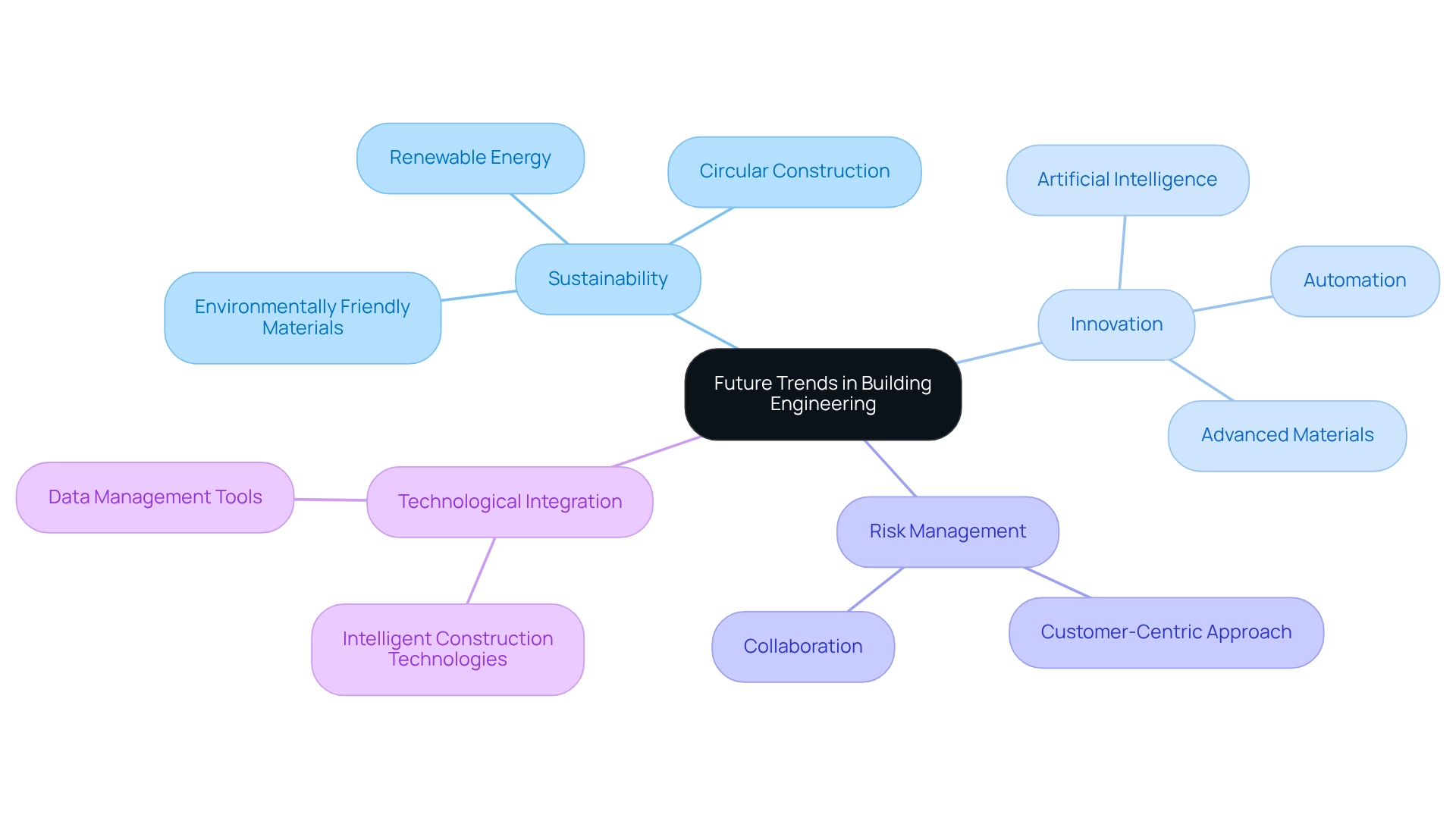
Overview
Building engineering represents a multidisciplinary field that centres on the design, construction, and maintenance of structures. It integrates various engineering disciplines to ensure safety, sustainability, and functionality. This article outlines the vital roles played by:
- Structural engineers
- Mechanical engineers
- Electrical engineers
- Environmental engineers
in navigating the complexities of construction projects. Furthermore, it highlights the importance of collaboration and innovation in addressing contemporary challenges and advancing the built environment. By engaging with these experts, stakeholders can effectively tackle the pressing demands of today’s construction landscape.
Introduction
In the dynamic realm of construction, building engineering emerges as a pivotal discipline that intricately weaves together various engineering branches to create functional and sustainable structures. As the industry grapples with challenges such as rising costs and labour shortages, the role of building engineers becomes increasingly vital in ensuring safety, energy efficiency, and compliance with evolving regulations.
With a significant portion of the global workforce engaged in construction, the demand for innovative solutions and effective project management has never been more pressing. This article delves into the multifaceted world of building engineering, exploring its key specialisations, educational pathways, and real-world applications. Furthermore, it addresses the challenges and future trends shaping this essential field, providing insights that underscore the importance of engaging with building engineering expertise.
Defining Building Engineering: An Overview
Structural design is a crucial domain within the development sector, focusing on the design, creation, operation, and maintenance of structures. This specialised field integrates various branches, including structural, mechanical, electrical, and civil disciplines, to produce functional and sustainable structures. Structural engineers play an indispensable role in ensuring that these structures comply with safety regulations, achieve energy efficiency, and create comfortable environments for occupants.
Naismiths envisions becoming leaders in data-driven oversight and advisory services, enhancing the sector through commercially oriented consultancy. This vision underscores the significance of infrastructure development, particularly within the context of the global building industry, which employs over 100 million individuals and accounts for approximately 6% of global GDP. In 2024, the construction sector faced challenges such as rising costs and labour shortages, highlighting the urgent need for innovative solutions and effective management.
Successful construction initiatives exemplify the field’s impact. For instance, recent advancements in sustainable construction practises have led to energy-efficient structures that not only reduce operational costs but also minimise environmental impact. These initiatives demonstrate the importance of merging advanced technical methods with sustainable design principles, a focus that aligns with Naismiths’ commitment to providing data-driven guidance throughout the lifecycle of structures.
Property surveyors, integral to this process, assess all aspects of property ownership, including maintenance, defects, compliance, regulations, refurbishments, and reinstatement cost evaluations across various development projects. They ensure that clients possess accurate information and comprehensive data to support informed decision-making. Specialist perspectives illuminate the vital role of structural design in navigating the complexities of contemporary development.
Furthermore, the ongoing evolution of construction engineering methods, driven by technological advancements and a commitment to sustainability, solidifies the field as a cornerstone of the construction industry.
In conclusion, building engineering is vital to the construction sector, influencing outcomes and shaping the built environment.
As the sector continues to evolve, the importance of construction engineers in delivering innovative, safe, and sustainable solutions will only increase, despite the challenges that persist.

Key Specialisations in Building Engineering
Building engineering encompasses several critical specialisations, including structural, mechanical, electrical, and environmental engineering. Each discipline contributes uniquely to the integrity and functionality of construction projects, necessitating a collaborative approach among professionals.
Structural engineers are primarily responsible for ensuring the safety and stability of frameworks. They examine loads and stresses to create structures that can endure various environmental factors, thereby preserving the longevity of constructions. Recent trends in structural design for 2025 indicate a growing emphasis on innovative materials and techniques that enhance resilience against natural disasters, reflecting a shift towards more sustainable and adaptable designs.
Mechanical engineers play a pivotal role in creating heating, ventilation, and air conditioning (HVAC) systems, which are essential for maintaining indoor comfort and air quality. Innovations in mechanical engineering are increasingly centred on energy efficiency, with advancements in intelligent construction technologies that optimise energy use and lower operational costs.
Electrical engineers oversee the electrical systems within structures, ensuring that they are safe, efficient, and compliant with regulations. Their work encompasses the design of lighting, power distribution, and communication systems, which are essential to contemporary structure functionality. As the demand for renewable energy sources increases, electrical engineers are also investigating the incorporation of solar panels and energy storage solutions into architectural designs.
Environmental engineers tackle sustainability challenges by applying practises that encourage waste management and energy efficiency. Their knowledge is essential in creating approaches that reduce the environmental effect of construction and operation, in line with global sustainability objectives.
The cooperation among these fields is critical for the successful finalisation of construction projects. For instance, Naismiths’ surveyors play a crucial role during the contract phase, ensuring compliance and effective oversight throughout the development process. They evaluate risks from different viewpoints, collaborating closely with managers to keep initiatives on schedule and within budget.
This proactive strategy not only reduces potential issues but also encourages a collaborative spirit among all stakeholders, ultimately resulting in improved outcomes.
In summary, building engineering highlights the interconnected roles of structural, mechanical, electrical, and environmental engineers, each contributing to the overall success of construction initiatives. Their joint efforts, backed by Naismiths’ extensive project oversight expertise, not only improve project results but also foster innovation and sustainability in the building sector.
Educational Pathways: How to Become a Building Engineer
To embark on a career as a construction engineer, individuals typically begin by securing a bachelor’s degree in civil, architectural, surveying or a closely related field. Numerous academic programmes incorporate specialised courses that cover essential subjects such as systems design, structural analysis, and construction management, equipping students with the fundamental knowledge required in the field. Upon completing their degree, aspiring construction engineers are encouraged to pursue internships or entry-level positions to gain invaluable practical experience.
This hands-on exposure is crucial for cultivating the skills necessary to navigate the complexities of construction projects.
A significant milestone in advancing one’s career is obtaining professional qualification. This credential not only bolsters credibility but is often a prerequisite for higher-level positions within the industry. Additionally, ongoing education and certification in specialised areas, such as sustainable construction practises, project management, or advanced structural design, can greatly enhance career opportunities and adaptability in a rapidly evolving job market.
Current statistics indicate that the demand for construction engineers remains robust, with architectural, design, and related services employing approximately 20% of mechanical professionals.
Moreover, addressing the talent gap in this sector requires a continuous, collaborative strategy involving both public and private sector participants, highlighting the significance of educational pathways and career advancement within the field. For individuals considering their educational options, numerous universities in the UK are renowned for their civil programmes, providing a strong foundation for future construction professionals. As the landscape of building engineering continues to evolve, staying informed about educational requirements and emerging trends is essential for aspiring engineers seeking successful career trajectories. Furthermore, understanding the role of building surveyors is vital for building engineers.
Building surveyors assess all aspects of property ownership, including maintenance, defects, compliance, and regulations, which directly impacts success. They are responsible for services such as contract and task management, ensuring that projects adhere to legal and regulatory standards. Their expertise in identifying potential issues and ensuring quality assurance is invaluable, as it protects funders and investors financially when making decisions regarding construction ventures.
This collaboration between engineers and surveyors enhances the overall efficiency of consultancy, ensuring that projects are completed effectively and to the highest standards. Chartered surveyors, accredited by The Royal Institution of Chartered Surveyors (RICS), adhere to stringent professional standards, further validating their expertise in the field. Understanding what surveyors evaluate during assessments, such as structural defects, health and safety hazards, and environmental risks, enriches the dialogue and underscores the importance of their role in the construction process.

Real-World Applications of Building Engineering
Building design encompasses a wide range of real-world applications, significantly impacting both residential and commercial sectors. Building engineers play a pivotal role in crafting energy-efficient homes that utilise sustainable materials and innovative technologies. For instance, they implement advanced insulation techniques and renewable energy systems, resulting in substantial reductions in energy consumption and costs.
In commercial projects, construction engineers ensure adherence to safety standards while integrating advanced systems for heating, cooling, and electrical distribution, essential elements for operational efficiency. Moreover, construction engineers are tasked with retrofitting existing structures to enhance energy efficiency and minimise environmental impact. This is particularly relevant as urban areas increasingly face pressure to reduce carbon footprints and improve sustainability.
According to recent statistics, each month of delay in a task incurs an average cost overrun of 7.7%, highlighting the critical nature of timely and efficient engineering practises.
The influence of building engineering on urban development is profound; these professionals are instrumental in creating functional, sustainable spaces that cater to the needs of growing populations. Their expertise is vital in navigating the complexities of modern construction, ensuring that developments are not only viable but also environmentally responsible.
Naismiths has demonstrated its expertise through various projects.
As the industry evolves, understanding the essence of building engineering becomes essential, as construction engineers are increasingly called upon to adapt to new technologies and methodologies, reinforcing their role as key players in shaping the future of urban landscapes. Engineering and building companies, including Naismiths, are encouraged to focus on managing labour mismatches and enhancing technological integration to remain competitive in this dynamic environment.
Challenges in Building Engineering: Navigating Market and Regulatory Hurdles
The challenges faced by building engineers significantly impact the definition of building engineering and the success of development initiatives. Among these challenges, market volatility is particularly prominent, as fluctuating material costs and labour shortages present substantial risks to budgets and timelines. Currently, the construction sector is grappling with a labour shortage exacerbated by economic fluctuations, necessitating that engineers adapt swiftly to these evolving circumstances.
Regulatory compliance represents another critical area of concern. To grasp the essence of building engineering, engineers must navigate a complex landscape of building codes and regulations, ensuring that initiatives meet safety and legal standards. This requires not only a comprehensive understanding of current regulations but also the foresight to anticipate changes in legislation that could influence execution. Naismiths’ comprehensive monitoring guarantees that building work remains on track and compliant, providing engineers with essential support to manage these complexities effectively.
Naismiths employs specific methodologies, including regular compliance audits and risk evaluations, to ensure adherence to statutory requirements throughout the lifecycle of each initiative.
Technological advancements are transforming the industry, particularly in the realm of building engineering, with the emergence of Building Information Modelling (BIM) and sustainable building practices. Engineers must remain informed about these developments to maintain a competitive edge. The anticipated rise of new methods for creating structures, such as design-build, is projected to account for 47% of UK spending on development by 2026, underscoring the necessity for engineers to adopt innovative strategies that enhance efficiency and productivity.
Moreover, artificial intelligence is expected to boost sector profits by 71% by 2035, highlighting the importance of integrating advanced technologies into engineering to improve project outcomes. Perspectives from industry leaders further emphasise the necessity of teamwork and risk management in overcoming these challenges.
By fostering strong management skills and maintaining open lines of communication among stakeholders, building engineers can adeptly navigate the complexities of their initiatives. Naismiths’ customer-centric approach, which prioritises risk management and collaboration, further empowers engineers to deliver high-quality outcomes. Additionally, Naismiths’ project monitoring surveyors play a vital role in ensuring compliance and quality through regular site inspections and thorough reporting, which aids in anticipating and resolving potential issues.
As the building industry evolves, the ability to adapt to market fluctuations and regulatory changes will be essential for engineers striving for high-quality results in an increasingly competitive landscape. In light of these challenges, the building sector is poised for significant transformation, with the integration of advanced technologies and innovative practices becoming indispensable for compliance and success.

The Role of Project Monitoring and Advisory Services in Building Engineering
Project monitoring and advisory services are vital components of building engineering, providing essential supervision throughout the development process. Naismiths delivers extensive management services, including contract administration, risk management, and technical due diligence, aimed at identifying potential risks early and ensuring that projects comply with established timelines and budgets. Building engineers frequently collaborate with Naismiths’ monitors to assess progress, quality, and adherence to safety standards, an essential practise in today’s complex construction environment.
Implementing effective monitoring strategies not only mitigates risks but also enhances overall outcomes. For example, Naismiths’ surveyors guarantee full compliance and high-quality delivery through regular site visits, proactively addressing any issues that may arise. This underscores the importance of comprehensive supervision in achieving successful deliverables.
Consulting services also play a crucial role in guiding clients through complex decisions, ensuring that their investments are protected and aligned with their strategic objectives. Naismiths’ customer-focused strategy emphasises risk management and collaboration, ensuring that all parties achieve optimal results while maintaining high-quality standards throughout each project. Indeed, statistics reveal that only 34% of underperformers provide comparable training, highlighting the competitive advantage that proficient advisory services can offer.
In 2025, the significance of oversight in building engineering continues to grow, as claims during development often involve multiple parties, agreements, and distinct timelines. This complexity demands a robust oversight framework, making monitoring not merely beneficial but essential for successful construction management.

Future Trends in Building Engineering: Innovation and Sustainability
The future of building engineering stands on the precipice of a remarkable transformation, driven by innovation and a steadfast commitment to sustainability. As the building sector confronts pressing challenges, financial constraints identified by 40% of organisations as a significant barrier to achieving sustainability, there is a growing acknowledgement of the necessity for sustainable practises. Notably, 43% of construction firms view circular construction as a promising avenue for enhancing sustainability, indicating a shift towards more responsible resource management. Emerging technologies such as artificial intelligence, automation, and advanced materials are poised to revolutionise construction processes.
Building engineers will increasingly prioritise sustainable practises, integrating renewable energy sources and environmentally friendly materials into their designs. The adoption of intelligent construction technologies will further enhance energy efficiency and occupant comfort, aligning with the industry’s evolving standards.
As these trends unfold, engineers in the sector must adapt to remain competitive and contribute to a more sustainable constructed environment. The emphasis on risk management and collaboration, as underscored by industry experts, will be crucial in navigating this landscape. Naismiths Analytics emerges as an advanced cost forecasting tool that provides reliable data analysis, visualisation, and benchmarking based on live and historical data.
This commitment to innovation and sustainability will not only redefine building engineering but also pave the way for a more resilient and environmentally conscious construction industry. Get in touch with Naismiths to explore how we can support your projects.

Conclusion
Building engineering stands at the forefront of the construction industry, integrating multiple disciplines to create structures that are not only functional but also sustainable. This field is pivotal in navigating the complexities of modern construction, ensuring compliance with safety standards, and developing innovative solutions to address challenges such as rising costs and labour shortages. The collaboration among structural, mechanical, electrical, and environmental engineers fosters a comprehensive approach that enhances project outcomes and drives sustainability.
Educational pathways are crucial in preparing the next generation of building engineers. Emphasising the importance of internships and professional licensure, these pathways provide the practical experience and credibility needed in the field. The demand for skilled professionals remains robust, underscoring the necessity for continuous learning and adaptation to emerging trends and technologies. Furthermore, building engineers are increasingly tasked with retrofitting existing structures and integrating smart technologies, reflecting a commitment to environmental responsibility and energy efficiency.
As the construction industry evolves, challenges such as market volatility and regulatory compliance necessitate a proactive approach to project monitoring and advisory services. Effective oversight not only mitigates risks but also enhances the quality and timeliness of project delivery. The future of building engineering is poised for transformation, driven by innovation and a dedication to sustainable practises. By embracing these changes and fostering collaboration, building engineers can significantly impact the built environment, ensuring it meets the needs of future generations while promoting resilience and sustainability.